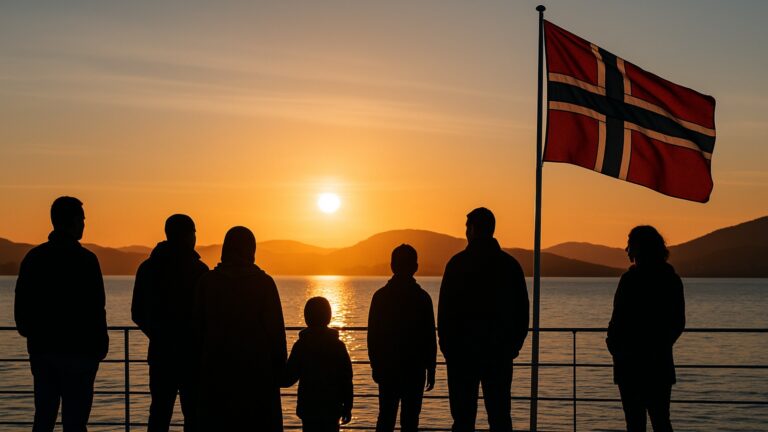The populist-right Progress Party (FrP) has called for zero net immigration from what it terms “high-risk countries,” sparking renewed debate over Norway's asylum and integration policies.
While the party's rhetoric on immigration may once have been seen as provocative or peripheral, FrP’s recent rise in the polls has brought their proposals into sharper national focus.

In February 2025, the party reached a high of 26.9% support in a TV 2 poll. This briefly made them Norway’s most popular party, ahead of the recently dominant Conservatives.
Although support slipped to 19% in April, the Progress Party remains a major player on the political right in the lead-up to the next parliamentary election in September 2025.
FrP Sets Out New Immigration Stance
Ahead of the party’s recent national conference, FrP’s immigration policy spokesperson Erlend Wiborg told Aftenposten that the goal is “zero net immigration from high-risk countries.”
These include several nations in the Middle East, Africa, and parts of Asia, which the party argues present challenges with integration, crime, and use of public services.
“Over time, Norway has accepted far too many immigrants from such countries. It is not sustainable and imposes enormous costs on taxpayers,” said Wiborg. “The experiences from Sweden are frightening.”
Wiborg referenced Sweden’s well-documented struggles with gang crime as a warning of what could happen in Norway without a tougher approach.
He added that the Progress Party wants to prioritise Christian refugees and tighten up the citizenship, permanent residence, and family reunification processes.
Measuring Local Integration
A new feature of the party’s policy proposal is to hold municipalities accountable for integration results.
Wiborg suggested publishing local statistics on crime, employment, welfare use, education, and participation in society, with the aim of halting immigration to municipalities that are deemed to be struggling.
“This way, municipalities can also learn from each other, while at the same time stopping all immigration to municipalities that clearly have major integration challenges,” he said.
The party also supports the creation of offshore asylum reception centres in third countries such as Rwanda—an idea also promoted by the centre-right Conservative Party, which FrP hopes to join in a potential future governing coalition.
A Changing Political Landscape
Under party leader Sylvi Listhaug, FrP has sought to balance its traditional hardline immigration stance with a broader platform.
In her opening speech at the party conference, Listhaug said she was “afraid for Norway’s future,” highlighting concerns around education, welfare, and crime.
“Our task as politicians is to pass on a better society to the next generation. But if we continue as we are now, we will fail,” she told party members.
Listhaug called for the introduction of a new financial literacy subject in schools, tougher penalties for gang crime, more individualised education, and stronger support for elderly care.
She also said Norway must be ready to spend more of its oil wealth on defence rather than foreign aid or refugee programmes.
“For every krone spent on receiving refugees or on aid, that’s a krone less for our military,” she said.
Broader Reflections on the Asylum System
The Progress Party’s tough stance comes at a time of increasing debate in Norway over the future of the asylum system.
A recent commentary in VG by political editor Frøy Gudbrandsen argued that while FrP’s positions were once dismissed by mainstream commentators, some of their criticisms are now being taken more seriously.
Gudbrandsen cited a new book by former UDI (Norwegian Directorate of Immigration) director Frode Forfang, Asylparadokset, which claims that the current global asylum system is outdated, ineffective, and unfair.
According to Forfang, the system fails to protect the most vulnerable and rewards those who can pay people smugglers and take the greatest risks to reach European borders.
“Everyone recognises the right to seek asylum, while doing everything they can to undermine that same right,” Forfang writes.
The book suggests that a shift towards more controlled resettlement, such as through the UN quota system, and protection close to conflict zones—as was done with Ukraine—might offer a more realistic and humane alternative.
Immigration in Numbers
In 2024, Norway received 4,970 standard asylum applications, according to the Norwegian Directorate of Immigration. However, over 90,000 Ukrainians have been granted temporary collective protection since Russia’s full-scale invasion in 2022.
While overall asylum numbers remain relatively low, immigration and integration remain politically charged topics in Norway, particularly as the country prepares for the next parliamentary election.
Whether immigration becomes a dominant issue in the campaign remains to be seen. But with the Progress Party polling strongly and shaping the national conversation, its influence on future immigration policy is difficult to ignore.

